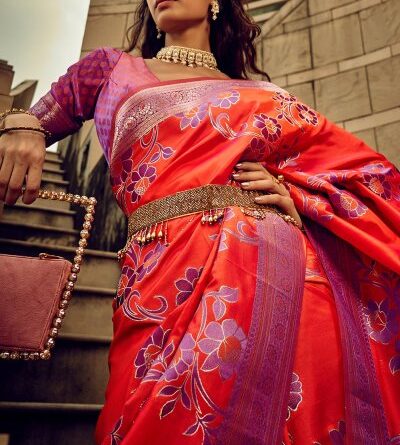Famous Handloom Sarees From The Western Part Of India
The western part of India comes with a rich cultural legacy, thereby giving rise to a multiple number of exquisite Indian handloom sarees. Every exquisitely crafted saree narrates a tale of custom, artistry, and the enduring allure of Indian textiles. These Indian dresses are loved not just within the boundaries of the nation, however, their fame has now crossed borders, thereby making them a global sensation in the fashion world. In this article we shall be looking at some of the well known traditional handloom sarees from the western part of India, particularly from the states of Maharashtra and Gujarat.
Patola sarees

Patola saree has originated in a place called Patan in Gujarat and is immensely popular for its elegance and grandeur. These sarees are regarded as some of the most sophisticated handwoven fabrics in the world because of their unique double ikat weaving. Only an experienced and a well knowledgeable person in this field can design this saree which takes almost six months to one year to get ready. Bright colors and geometric designs with motifs like flowers, birds, elephants, and dancing figures are the distinguishing features of Patola sarees. Earlier this saree was worn by women from royal and noble households, as it used to be the symbolic representation of status and wealth. Patola sarees have been handed down through the centuries as priceless antiques. Resist dyeing is the process used to create a Patola saree, in which the warp and weft threads are dyed in accordance with the design prior to weaving. The designs in the Patola saree are precisely aligned because of this painstaking technique and this further leads to a mirror image on both sides of the fabric. Apart from sarees, several other outfits are also available in Patola designs, the Indo western lehengas being the trendiest ones.
Bandhani sarees

Traditional Gujarati and Rajasthani art known as “bandhani,” or tie-dye, is renowned for its elaborate designs made by pinching the fabric with fingernails and binding it with threads before dying it. This technique further gives rise to a wide range of designs, typically found in Bandhani sarees ranging from basic dots to intricate motifs. In Gujarat, places like Bhuj, Mandvi, and Jamnagar are particularly well-liked for their Bandhani sarees. Because they are frequently composed of airy materials like silk and cotton, these sarees are perfect for the hot, dry atmosphere of the area. Vibrant hues like red, yellow, green, and blue are worn frequently during religious events and weddings because they are symbolic of celebration. Every Bandhani saree is different from the next since no two sarees are exactly the same. The artisans take great delight in their work and use highly sophisticated techniques to create these patterns, guaranteeing that every piece is a work of art.
Mashru sarees
Mashru sarees have a smooth, glossy silk surface and a soft cotton backing. They are a unique blend of silk and cotton. Since silk was deemed opulent and was forbidden for men to wear in Islam, the Muslim community has historically worn these Gujarati sarees. Mashru sarees gained acceptance due to their cotton backing, and both men and women started to favor them. Mashru sarees, which are woven using the satin weave technique, are renowned for their vivid, bright stripes and geometric designs. These sarees seem beautiful yet are comfortable to wear thanks to the silk and cotton blend.
Paithani sarees

One of the most highly regarded handloom sarees in India is the Paithani saree, which takes its name from the Paithan town in Maharashtra. Paithani sarees, which are renowned for their vivid hues and finely woven pallu, are crafted from the highest grade silk and zari (gold or silver thread). These sarees are customarily worn for weddings and other special occasions, and they are frequently connected to monarchy. A Paithani saree’s pallu, which is woven in pure gold or silver thread and frequently features intricate motifs of peacocks, flowers, and geometric shapes, is what makes them unique. The tiny butis (small motifs) that embellish the body of the saree contribute to its grandeur and elegance. A Paithani saree requires careful weaving, which can take several months to finish. Each saree is a work of art that reflects the rich cultural legacy of Maharashtra, thanks to the extraordinary talent of the artisans.
Khandua sarees
Another exquisite item from Maharashtra is the Khandua saree, often called the Khandesh saree. These sarees, which are native to the Khandesh area, are prized for their grace and simplicity. Since they are often composed of cotton, they are ideal for daily wear, particularly given the region’s hot and muggy atmosphere. The intricacy of Khandua sarees is what makes them so beautiful. The simplistic designs of Khandua sarees prioritize comfort and practicality over ornate Paithani sarees. The body of the sarees is often plain with a striking border that can be embellished with stripes or basic geometric motifs. Women who like subtle elegance frequently wear Khandua sarees during festivals, religious rituals, and other cultural events.
Summing up
These are some of the famous handloom sarees from the western part of India which you can prefer this festive season along with other Indian outfits, such as Anarkali suits and alike.

